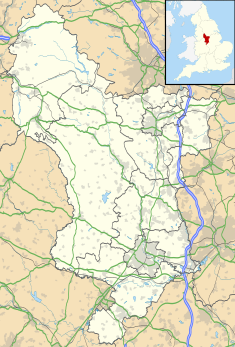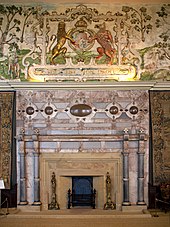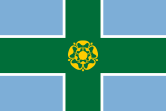| Hardwick Hall | |
|---|---|
 "More glass than wall" "More glass than wall" | |
| Type | Prodigy house |
| Location | Doe Lea, Ault Hucknall, Derbyshire |
| Coordinates | 53°10′08″N 1°18′32″W / 53.1688°N 1.3088°W / 53.1688; -1.3088 |
| OS grid reference | SK 463 637 |
| Built | 1590–1597 |
| Architect | Robert Smythson |
| Architectural style(s) | Renaissance |
| Owner | National Trust |
| Listed Building – Grade I | |
| Official name | Hardwick Hall |
| Designated | 11 Jul 1951 |
| Reference no. | 1051617 |
 | |




Hardwick Hall in Derbyshire is an architecturally significant country house from the Elizabethan era, a leading example of the Elizabethan prodigy house. Built between 1590 and 1597 for Bess of Hardwick, it was designed by the architect Robert Smythson, an exponent of the Renaissance style. Hardwick Hall is one of the earliest examples of the English interpretation of this style, which came into fashion having slowly spread from Florence. Its arrival in Britain coincided with the period when it was no longer necessary or legal to fortify a domestic dwelling.
The British Army's 1st Parachute Brigade was formed at Hardwick Hall in 1941. The Airborne Forces Depot and Battle School was located on the grounds of the estate from 1942–1946.
After ownership for centuries by the Cavendish family and the line of the Earl of Devonshire and the Duke of Devonshire, ownership of the house was transferred to the Treasury in 1956 and then to the National Trust in 1959. The building was approaching ruin and required stabilisation and restoration.
The Hall is fully open to the public and received 298,283 visitors in 2019.
History
16th century
Sited on a hilltop between Chesterfield and Mansfield, overlooking the Derbyshire countryside, Hardwick Hall was designed by Robert Smythson in the late 16th century. Ordered by Bess of Hardwick, Countess of Shrewsbury and ancestress of the Dukes of Devonshire, it was owned by her descendants until the mid-twentieth century.
Bess of Hardwick was the richest woman in England after Queen Elizabeth I, and her house was conceived to be a conspicuous statement of her wealth and power. The windows are exceptionally large and numerous at a time when glass was a luxury, leading to the saying, "Hardwick Hall, more glass than wall." The Hall's chimneys are built into the internal walls of the structure, in order to give more scope for huge windows without weakening the exterior walls.
The house's design also demonstrated new concepts not only in domestic architecture, but also of a more modern way in which life was led within a great house. Hardwick was one of the first English houses where the great hall was built on an axis through the centre of the house, rather than at right angles to the entrance.
Each of the three main storeys has a higher ceiling than the one below, the ceiling height being indicative of the importance of the rooms' occupants: least noble at the bottom and grandest at the top.
A wide, winding, stone staircase leads up to the state rooms on the second floor; these rooms include one of the largest long galleries in any English house. There is also a tapestry-hung great chamber with a spectacular plaster frieze illustrating hunting scenes; the room has been little altered.
Bess employed a decorator, named as John "Paynter" in her accounts. He used chalk and size made from glovers' offcuts. Pigments including blue bice, verdigris, massicot, and vermilion were bought in 1599. John varnished and coloured the panelling of the great chamber. He gilded some details. John's paintwork supplemented and mended the cloth hangings, and he also painted cloth hangings in imitation of tapestry.
The architecture was influential, and in March 1608 the Earl of Salisbury, who was planning new buildings at Hatfield House, asked Bess's son-in-law, the Earl of Shrewsbury, for a plan, "any rowgh drawght of Hardwick". Hardwick was but one of Bess's many houses. Each of her four marriages had brought her greater wealth. She was born in her father's manor house on the site of the later, now old Hall at Hardwick, which today is a ruin beside the 'new' hall.
17th century
Following Bess's death in 1608, the house passed to her son William Cavendish, 1st Earl of Devonshire. His great-grandson, William, was created 1st Duke of Devonshire in 1694. The Devonshires made Chatsworth, another of Bess's great houses, their principal seat. Hardwick thus was relegated to the role of an occasional retreat for hunting and sometime dower house. As a secondary home, it escaped the attention of modernisers and received few alterations after its completion.
The famed political philosopher Thomas Hobbes died at the Hall in December 1679. For the previous four or five years, Hobbes had lived at Chatsworth. Hobbes had been a friend of the family since 1608 when he first tutored William Cavendish. After his death, many of Hobbes' manuscripts were found at Chatsworth House.
19th century
From the early 19th century, the antique atmosphere of Hardwick Hall was consciously preserved. A low, 19th-century service wing is fairly inconspicuous at the rear.
In 1844, William Cavendish, 6th Duke of Devonshire published a book called Handbook to Chatsworth and Hardwick. It was privately printed and provided a history of the Cavendish family's two estates.
20th century
Second World War
On 31 August 1941, the decision was made to form the 1st Parachute Brigade under Brigadier Richard Gale at Hardwick. Army Northern Command leased 53 acres of the estate to establish a camp of red-brick huts with training areas. It included a gymnasium, a cookhouse, cinema and medical facility. Hardwick Camp then became the new nucleus for parachute training and physical selection for airborne forces. On 15 December 1941, the 2nd Parachute Battalion and 3rd Parachute Battalion formed at Hardwick with the 1st Air Troop Royal Engineers, the first airborne Royal Engineers unit, and a skeleton Royal Signals Squadron.
The camp was southwest of the Hall and consisted of a 250-foot (76 m) parachute jump tower, assault courses and trapeze in-flight swing training structures. When pre-jump training was successfully completed, the recruits that passed out were required to speed-march approximately 50 miles (80 km) to join the parachute course at RAF Ringway. A tethered barrage balloon was also installed on 1 November 1941 to provide refresher training for qualified parachutists and to supplement descents made from the jump tower.
In 1942, when the 1st Parachute Brigade moved from Hardwick to Bulford Garrison, an Airborne Forces Depot was formed at Hardwick from the units left behind. It started as an unofficial establishment but was created as a properly organized unit, training and holding recruits before they went to the Parachute Training School, as well as rehabilitating the temporary unfit from injuries. The War Office approved a War Establishment for the depot on 25 December 1942, appointing Lt Col W. Giles MC (Ox and Bucks) as its first commanding officer. The depot was given an extended role and consisted of a depot company, a pre-parachute training company, a battle school, a holding company and an airfield detachment, which was stationed at No.1 Parachute Training School (No.1 PTS), RAF Ringway. During this period, all pre-jump ground training was moved from Hardwick to Ringway.
In March 1944, the Battle School closed, and the Holding Unit was moved to nearby Clay Cross, while a new preliminary Battle School was set up at Dore and Totley. The Selection Company and Depot Administrative Unit remained at Hardwick.
In April 1946, the Depot moved to Albany Barracks on the Isle of Wight and Airborne Forces activity at Hardwick Hall ceased.
Post War
When the British Army left their battle school and village after the war, it was turned into a Polish resettlement camp for allied soldiers. Here Polish veterans, and later Hungarian refugees, were homed until they managed to find a more permanent place to stay.
In 1950, the unexpected death of the 10th Duke of Devonshire, with the subsequent death duties (rated at 80%), caused the sale of many of the Devonshire assets and estates. At this time, Hardwick was occupied by Evelyn, Duchess of Devonshire, the widow of the 9th Duke. The decision was taken to hand the house over to HM Treasury in lieu of Estate Duty in 1956. The Treasury transferred the house to the National Trust in 1959. The Duchess remained in occupation of the house until her death in 1960. Having done much, personally, to conserve the textiles in the house as well as reinstating the traditional rush matting, she was to be its last occupant.
Today

Hardwick Hall contains a large collection of embroideries, mostly dating from the late 16th century, many of which are listed in the 1601 inventory. Some of the needlework on display in the house incorporates Bess's monogram "ES", and may have been worked on by Bess herself. There is a large amount of fine tapestry and furniture from the 16th and 17th centuries. A remarkable feature of the house is that much of the present furniture and other contents are listed in an inventory dating from 1601. The Sea Dog Table is an especially important piece from around 1600, and the Eglantine Table has an inlaid top of interest to musical historians.
Hardwick is open to the public. It has a fine garden, including herbaceous borders, a vegetable and herb garden, and an orchard. The extensive grounds also contain Hardwick Old Hall, a slightly earlier house which was used as guest and service accommodation after the new hall was built. The Old Hall is now a ruin. It is administered by English Heritage on behalf of the National Trust and is also open to the public. Many of the Old Hall's major rooms were decorated with ambitious schemes of plasterwork, notably above the fireplaces. Remarkably, impressive fragments of these are still to be seen (protected by preservative coatings and rain-shields), though most of the building is unroofed.
Both Hardwick Hall and the Old Hall are Grade I listed (the highest designation) by Historic England.

Dan Cruickshank, an historian specialising in architecture, selected the Hall in 2006 as one of his five choices for Britain's Best Buildings, a documentary series made by the BBC for television. Innovative in its own time, it would serve, three centuries later, as a source of inspiration for the enormous Main Exhibition Building at the Philadelphia Centennial Exhibition of 1876. Hardwick Hall was an ideal model for a building which was intended to merge historicism with the large expanses of glass that had become de rigueur for the main exhibition halls at international expositions and fairs in the wake of the success of The Crystal Palace constructed for the 1851 London Exhibition.
In March 2012, a £6.5m restoration was completed; this included the addition of a large restaurant. In December 2020, three years of additional restoration had been completed and further work was being planned.
In modern media
Hardwick Hall was the setting for the 10-part BBC series Mistress of Hardwick, broadcast in 1972. Hardwick Hall was used in the 1978 Connections TV series to illustrate a long series of changes that occurred in home design as a result of the Little Ice Age. The house was described in the 1985 TV documentary Treasure Houses of Britain. Hardwick Hall was used for the exterior scenes and some interior scenes of Malfoy Manor in the 2010 film Harry Potter and the Deathly Hallows – Part 1.
See also
- Grade I listed buildings in Derbyshire
- Listed buildings in Ault Hucknall
- Chatsworth House
- Stainsby Mill
References
- "History of Hardwick Old Hall". English Heritage. Retrieved 14 April 2021.
- "ALVA – Association of Leading Visitor Attractions". www.alva.org.uk. Retrieved 4 November 2020.
- ^ Burke, James (1978). Connections. London: BBC Books. pp. 157–164.
- Another version is "more window than wall." Sir Nikolaus Pevsner writes, "The little rhyme is: 'Hardwick Hall, more window than wall.' Nikolaus Pevsner, A History of Building Types. London: Thames and Hudson, 1976, p. 324, note 80.
- Basil Stallybrass, 'Bess of Hardwick's Building Accounts', Archaeologia, 64 (1913), pp. 382–84
- Edmund Lodge, Illustrations of British History, vol. 3 (London, 1791), p. 350.
- "Thomas Hobbes (1588–1679)". BBC. Retrieved 14 April 2021.
- Malcolm, Noel (2003). Aspects of Hobbes. Oxford: Oxford University Press. p. 80. ISBN 0199247145.
- "Handbook of Chatsworth and Hardwick". Chatsworth. Retrieved 14 April 2021.
- ^ "Airborne Forces Depot Hardwick Hall | ParaData". www.paradata.org.uk. Retrieved 19 June 2024.
- ^ "The Parachute Regiment and Hardwick Hall". National Trust. Retrieved 19 June 2024.
- "BBC - WW2 People's War - Hardwick Hall, to be trained as a parachutist". www.bbc.co.uk. Retrieved 19 June 2024.
- "BBC - WW2 People's War - D-Day, Normandy, 1944". www.bbc.co.uk. Retrieved 19 June 2024.
- Chatsworth: Home of the Duke and Duchess of Devonshire; Derbyshire Countryside Ltd; 2005: p56.
- Girouard, Mark (2006). Hardwick Hall. National Trust. p. 72. ISBN 978-1-84359-217-4.
- Historic England. "Hardwick Hall (Grade I) (1051617)". National Heritage List for England. Retrieved 14 October 2015.
- Historic England. "Hardwick Old Hall (Grade I) (1052337)". National Heritage List for England. Retrieved 14 October 2015.
- Cruickshank, Dan. "Britain's Best Buildings". BBC Four. Archived from the original on 20 August 2004. Retrieved 3 June 2008.
- Nikolaus Pevsner, A History of Building Types. London: Thames and Hudson, 1976, p. 248.
- "Duke of Devonshire opens Derbyshire's Hardwick Hall after revamp". BBC News. 27 March 2012. Retrieved 14 April 2021.
- "Hardwick Hall Building Repairs Project". National Trust. Retrieved 14 April 2021.
- "Harry Potter scenes shot at Derbyshire's Hardwick Hall". BBC Derby. 24 November 2010. Retrieved 10 April 2014.
Further reading
- Adshead, David and Taylor, David A. H. B., editors, Hardwick Hall: a Great Old Castle of Romance, Yale University Press, 2016.
- Durant, David N., Bess of Hardwick, Peter Owen Publishers, 1999 (Revised edition).
- Durant, David N., The Smythson Circle, Peter Owen Publishers, 2011.
External links
- Hardwick Hall information at the National Trust
- Images of Hardwick Hall taken by Photographer John Gay
- Detailed Tour of the Hardwick Estate
- Listing Building Images of Hardwick Hall
- Hardwick Old Hall visitor information from English Heritage
- Panoramic images and QuickTime VR movies here and here
- Several photographs of the exterior taken in 1989
- Floor plan for third floor from B. Fletcher, History of Architecture, (London, 1921) pg. 700
- Drawing of plasterwork over fireplaces, from F. Simpson, A History of Architectural Development, Vol. III. (London: Longmans, Green and Co., 1922) p. 267, fig. 221
- Hardwick Hall, Doe Lea Robert Smythson for Bess Hardwick, 1597 (Floor plans and plan of grounds) PDF by London Metropolitan University
- English Heritage sites in Derbyshire
- Grade I listed buildings in Derbyshire
- Grade I listed houses
- Grade I listed museum buildings
- Country houses in Derbyshire
- National Trust properties in Derbyshire
- Tourist attractions in Derbyshire
- Houses completed in 1597
- Historic house museums in Derbyshire
- Gardens in Derbyshire
- Textile museums in the United Kingdom
- Elizabethan architecture
